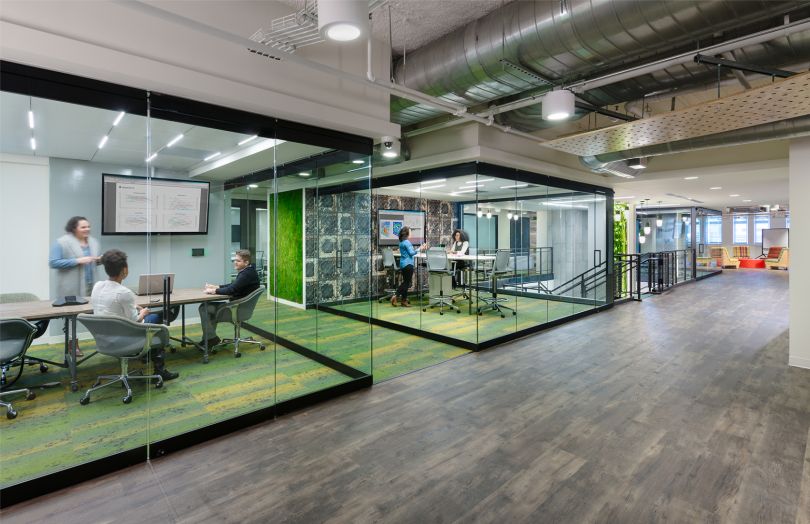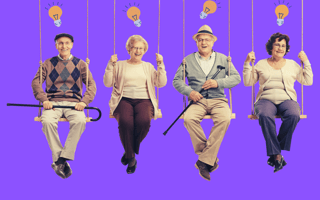Few designers think of older adults as their target demographic, but overlooking their needs can mean missing out on big opportunities.
“If you’re not considering the 50-plus audience, you’re actually doing yourself a disservice,” said Andre Bierzynski, innovation director at AARP Innovation Lab, whose mission is to encourage companies to develop tech products with older users in mind.

While use of technology is negatively correlated with age, a majority of older adults are technologically savvy. According to Pew Research Center studies, over half of adults 65 and older own smartphones and 73 percent use the internet — and trends suggest those percentages will continue to grow.
But companies often still fail to consider older users when developing tech products. AARP recently collaborated with a company that was surprised to discover — despite actively marketing toward a young demographic — that a significant portion of its customers were much older.
“They are targeting young Millennials, young Millennial women in particular,” Bierzynski said, “They looked at their analytics and found that, interestingly, almost 25 percent of their sales — without even trying — were going to people 50 plus.”
That’s great news for the company, but it also highlighted how neglecting to take older users into account can result in design decisions that create bad user experiences for significant portions of customers.
“You look at their landing page, and it is speaking directly to a 26-year-old woman,” Bierzynski said. “Imagine a landing page that maybe is a little bit more inclusive by age — it would be interesting in those cases to see what type of outcome they might get.”
AARP is a nonprofit that advocates for Americans over the age of 50. In 2016, the organization launched its Innovation Lab to promote the interests of older users in the tech ecosystem. The Lab occupies a 10,000-square-foot space in the heart of Washington, D.C., where employees hold design-thinking workshops, facilitate feasibility testing sessions and otherwise engage with tech startups.
“We actually used to build products from scratch ourselves,” Bierzynski said. “We have recently pivoted, and now we’re collaborating directly with startups — we are working very closely with startups to do mentoring, coaching, doing things like consumer focus groups: you research a lot of different things with them to help them figure out opportunities for them to take advantage of the 50-plus market.”
The organization also seeks to influence tech innovation by holding pitch competitions and working with startups at tech accelerators, and ran its most recent competition as a collaboration with MassChallenge HealthTech for startups in the gaming space.
Diversity Among Older Users Pose Unique Design Challenges
It’s challenging to know where to start when designing with older users in mind, in large part because older users are not a homogeneous group.
“As everyone knows, the 50-plus population is very diverse itself, it’s not a monolith,” Bierzynski said. “Something that’s really attractive to a 52 year old may not be something that a 81 year old may be interested in — whether it’s for usability reasons or just value proposition.”
Still, there are general guidelines to follow. Spire Digital, a software development company based in Denver, published a list of design do’s and don’ts that emphasized simplicity and clarity, which Bierzynski approved of. He stressed the importance of considering older users’ points of view when designing and of bringing in older users when doing user testing — especially because designers are generally much younger.
“When we design products, we’re designing it based on a lot of our experiences and a lot of shared experiences with people we know,” Bierzynski said. “It’s important that we start bringing other folks into the fold to get their feedback. Too often, we don’t necessarily include [older folks] in the prototype, design and early build phases to give us those types of feedback that we’re looking for in the products we build.”
Easy Button Clicks Are Critical
He went over some of the common problematic design decisions that affect older users, such as designs that require very precise user interactions, ones that demand action from the user without being explicit and ones that exacerbate visual impairments.
“Making it easy to click buttons is critical, especially on mobile,” Bierzynski said. “One thing you hear from older people is, ‘I fat-finger things a lot.’ They’re pressing, but they’re not getting the precise presses.”
Designs that rely on precise clicks may seem sleeker, but they result in bad user experiences for some older users and users with disabilities.
“One thing you hear from older people is, ‘I fat-finger things a lot.’ They’re pressing, but they’re not getting the precise presses.”
“A lot of the things we use today require some of the most precise touches to get the response,” Bierzynski said. “Having some wiggle room there is important [for] an older population that is not able to do some of the more precise motions, particularly [for] people that have degenerative diseases.”
He said that many general accessibility design concerns also apply to older users, such as text being of a readable font size, sounds not being confusing and being careful about using colors to convey information.
“Colors are important,” Bierzynski said. “You want to really make sure that you’re not using colors that can potentially impact people who are suffering from colorblindness.”
Bierzynski said that, while he has not seen many centralized resources to help designers design for older users, that was something the Lab hopes to work on next year.
“It is one of our goals for 2021,” he said. “We’re trying to help the startups in industry tap into markets, scale their businesses — but we know there’s also an opportunity for us to lend some thought leadership in that space as well.”

Smart Home Tech Needs Simpler Interfaces
The Lab’s mission statement is to “empower people to choose to live how they want as they age, through innovation.” Unsurprisingly, innovation in the smart home space is especially of interest to the Lab, Bierzynski said.
“People want to age in their homes, they want to stay in their homes longer,” he said.
Although smart home tech is a rapidly growing industry, many aspects of smart home devices make the products difficult to use — for older adults, but also for users in general.
“You look at some of the things that are built there, and they’re not built for people who don’t have a Ph.D.,” Bierzynski said, explaining that many devices are not compatible with one another, making management of devices difficult and confusing.
“Making sure [devices] are interoperable — making sure that the sensor on the door talks to the camera, talks to the fridge — making sure they’re all speaking the same language so that you can actually get the true benefits, is going to be super important,” Bierzynski said.
He said that the virtual reality and augmented reality spaces were also of interest to the Lab, as they are potentially of value to older adults in terms of entertainment and staying connected to friends and family.
Good Design Should Handle User Failure Gently
“Minimizing frustration of experience is key,” Bierzynski said. “Research shows that older adults get frustrated quicker when they can’t accomplish the task they set out to accomplish.”
He said it’s important to minimize the “feeling of failure” users may experience when products aren’t designed in a way that makes sense to them. For instance, user input forms should prioritize aiming to focus attention at the right screen location, rather than showing red errors when users neglect to fill in a field.
“It’s not a failure on your part.”
“There are some interesting ways in which you can design those elements, such that it brings it to the forefront for people,” Bierzynski said. “[Let users know,] ‘It’s not a failure on your part.’”
Ultimately, good design for older users is about keeping them in mind and valuing their user experience as much as that of younger users.
“What we have to be very mindful of, from a design perspective, is looking at [older users’] values and why they’re actually using a product,” Bierzynski said. “You really want to get into the mind of your user.... Just like you would design it for a 27 year old and understand what a 27- year old’s motivations are.... You want to really make sure you capture why the person is trying to use your site and make it as easy as possible.”
After all, growing older is something everyone experiences — even designers.




